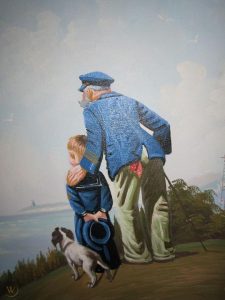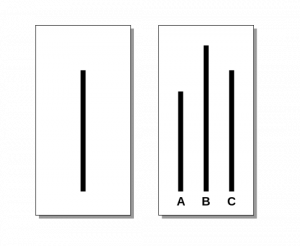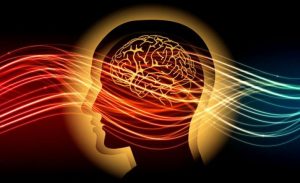Observing and releasing the binds of the conditioned mind through Yoga Therapy and Meditation.
´Give me child until age seven and I will show you the man´ – Ignatius of Loyola
The whole point and purpose of the art and science of Yoga and Yoga Therapy is to help each individual experience for themselves their own limitless access bliss. The very foundation of experiencing bliss exists first and foremost in the voluntary acceptance and responsibility of personal freedom. Nonetheless, the acceptance and utilization of this freedom is often limited by our social-cultural conditioning.

It is hypothesized that until age seven we act like sponges to the world around us. We soak up all the information coming in with little to no filter and store what is recorded into our subconscious and unconscious -a place beyond conscious thought and language. This early unfiltered processing of information enables the human child to learn and adapt quickly to their physical and social environment. It is through this social conditioning that a child learns the necessary, highly complicated and subtle social cues that enable it to become accepted within its tribe. Due to the fact that human beings, especially children, are physically quite fragile, learning how to become socially accepted and supported within ones own tribe is fundamental to survival.
As illustrated by the quote above, this early childhood programming goes deep and greatly influences our adult life. Yoga Therapy and psychology recognize that most of the time we are not even aware that this childhood programming is running in the background influencing every decision we make and action we take. On the positive side, thanks to this unconscious programming we are able to connect with other human beings with lighting, intuitive speed as our interactions are not weighed down with the slow and cumbersome processes of conscious thought telling us how to move, change our tone of voice or maneuver between various social settings. All these cues happen automatically. However, these same unconscious cues that we use to ameliorate and ease our way through our daily interactions can be can be manipulated to subvert our sovereignty as human beings and cause great harm and destruction.
Experiments into the human psyche: How free are we?
The world of behavioral psychology has many interesting and disturbing experiments demonstrating just how easily our perceived freedom can be hijacked by the right unconscious cue such as – authority, peer pressure and self-image. These unconscious cues have great power because they tap into the childhood fear of survival and abandonment. The following experiments demonstrate how fear can override logical thought patterns and without conscious awareness, move an individual to perpetuate inhumane, cruel and objectively incorrect behaviors and decisions.
The Authority Cue: The Milgram Experiments
Shortly after the trials of War II criminal Adolph Eichmann had begun, Stanley Milgram designed an experiment to explore Eichmann´s defense that he was just following orders. Beyond the walls of Yale University, he had an actor don a white lab coat and pretend like he was running an experiment on learning. Various volunteers came in to participate in the experiment with the promise of $4.50 as compensation for just showing up. The man in the white lab coat told the volunteer participants that their task was to shock another participant on the other side of a wall whenever they answered a question incorrectly. Unbeknownst to the volunteer participant giving the shock, the participant receiving the shock was a confederate in the experiment (they knew the true purpose of the experiment, knew what answers to give and faked their reactions to the administered shocks).You can watch videos of the experiment here:
As the volunteer participant administered shocks to the confederate for wrong answers, it seemed innocent enough until the the volts increased bit by bit from 15 volts to 375 volts and the confederate began screaming in pain and protesting and begging for the participant to stop. This would go on until the volunteer participant finished with a shock of 450 volts and was met with silence to his questions – an indication that they had shocked the confederate participant to the point of death.
Results: All participants asked the authority figure (the man in the lab coat) if they could stop. There is evidence that many tried to defy the orders in various creative ways. However less than 40% actually stopped before the shocks became fatal and a meta-analysis of the same experiment carried out in the USA and other countries, showed that the majority of participants (61-66%) continued the shocks to fatality. In some experiments it was as high as 91%. The participants who refused to administer the final shocks did not insist that the experiment be terminated and only went to check on the health of the apparent victim after requesting permission to leave.
The Peer Pressure Cue: Asch Conformity Experiments
“That intelligent, well-meaning, young people are willing to call white black is a matter of concern.” – Solomon Asch
The Asch conformity experiments or the Asch paradigm were a series of studies developed in the 1950s. It consisted of groups of eight male college students where all but one of the participants were actors (or confederates) in the experiment.

The actors knew the true aim of the experiment, but were introduced to the subject as other participants. Each student viewed a card with a line on it, followed by another with three lines labeled A, B, and C. One of these lines was the same as that on the first card, and the other two lines were clearly longer or shorter. Each participant was then asked to say aloud which line matched the length of that on the first card. The group was seated such that the real participant always responded last. Subjects completed 18 trials.
Results: In the control group, with no pressure to conform to confederate actors, the error rate on the critical stimuli was less than 1%. However, when placed within the group of confederates who gave the wrong answer, only 25 percent of the sample consistently defied the incorrect majority opinion. Meaning that overall, 75% of participants were swayed by the incorrect opinion of the group despite choosing the correct answer on their own.
The Self-Image (Ego Cue): Self Serving Bias
Then there is the Self-Serving Bias. Basically, the self-serving bias is a cognitive or perceptual process that distorts objective reality in an effort to maintain a perception of oneself in an overly favorable manner. In Yoga Therapy, this would be a defined as protecting the ego – the false self. These cognitive and perceptual tendencies perpetuate illusions and error. In experiments, an example of this would be someone who takes an exam thinking they did really well, only to find out later that they had failed. The self-serving bias was first committed by thinking that they did incredibly well when indeed they did not. This same cognitive error would be committed again by same person when blame is placed upon the examiner rather than acknowledging that they themselves did not know the material well and should have studied more.
Another example would be reading the descriptions of the above experiments and thinking to yourself that you would never shock someone to the point of death or fall victim to the Asch Paradigm. According to previously highlighted statistics, your self assessment would most likely be wrong and refusal to acknowledge this would be an example of the self-serving bias. There are many experiments that have tested and validated this tendency in academics, relationships and work environments.
Fear vs. Free Will
´I contemplate that I might have the potential to be a Nazi´ – Jordan Peterson
These experiments are absolutely fundamental for us to understand just how easily the human mind is manipulated into thinking that it is not free to decide. They demonstrate how quickly the logical adult mind can revert to the subconscious training of the child and its unconscious core need for acceptance by authority, its fellow tribal members and own positive self-image in order to survive.
- Milgram created his experiments in an attempt to understand how was it that so many people followed the atrocities and commands sent out by Adolf Hitler and other Nazi leaders. He found his answer in the innate human habit that we all have somewhere in our unconscious, to obey and submit to perceived authority figures. He discovered that as long as said authority figure was telling you to do something than individual morality and decision making was overridden by obedience to authority and the initial perceived personal responsibility (and guilt) for ones own actions were removed. He labeled this the agentic state theory. Similar results were also observed in the Stanford Prison experiments.
- The Asch conformity experiments generalized the findings of Milgram´s experiments to the authority of the group. He demonstrated how even when the perception of the individual was objectively correct and that of the group was wrong – the individual’s correct assessment was overridden by the incorrect dictates of the group in a process now termed theory of conformism.
- Finally the self-serving bias experiments demonstrate that we all have an image of ourselves that we aim to maintain for the benefit of our own self-esteem – our own ego. Most of us would like to think that we are good people who would never have the capacity to inflict the harm upon our fellow human beings. We look on in horror as we watch videos or read about the historical tragedies of Maoist China, Nazi Germany, Stalin’s Russia or the killing fields of the Khmer Rouge in Cambodia…but statistically and objectively speaking we would be wrong. As observed in the above experiments, it is far more likely that you would sacrifice your individual freedom and that of others in order to fulfill the unconscious drive for safety as manifested via the obedience to authority figures and group opinion.
Out of the Lab and into the Real World
“Between stimulus and response there is a space. In that space is our power to choose our response. In our response lies our growth and our freedom.” – Viktor Frankl
As illustrated above it goes beyond philosophical probability and into measurable reality that human beings are easily manipulated and controlled by their past conditioning, peer pressure and perceived figures of authority. And so to truly live free, we must ask ourselves how have we been conditioned and what can we learn from these experiments in the current context of our modern world and life?
 By understanding how easily hijacked our minds can be by unconscious drives we can begin to observe our decision processes and critically contemplate if the decisions are our own or if they are the result of one of the above cognitive traps. As outlined in the previous blog posts of 8 limbs of Yoga and Western Psychology and Hatha Yoga: The Union Towards Liberation the perception of freedom and consequential personal responsibility is fundamental to our happiness and well-being. From a Yoga philosophy and Yoga Therapy perspective this is because being free is the very essence of our being. Anything that would limit this freedom and our capacity to respond risks pulling us away from the essence of our bliss and into misery…and what is the point of living if freedom and bliss is traded for perceived safety and misery?
By understanding how easily hijacked our minds can be by unconscious drives we can begin to observe our decision processes and critically contemplate if the decisions are our own or if they are the result of one of the above cognitive traps. As outlined in the previous blog posts of 8 limbs of Yoga and Western Psychology and Hatha Yoga: The Union Towards Liberation the perception of freedom and consequential personal responsibility is fundamental to our happiness and well-being. From a Yoga philosophy and Yoga Therapy perspective this is because being free is the very essence of our being. Anything that would limit this freedom and our capacity to respond risks pulling us away from the essence of our bliss and into misery…and what is the point of living if freedom and bliss is traded for perceived safety and misery?
This does not mean that we start doing whatever we want whenever we want without any regard to the consequences it might have upon our world and fellow human beings. Ahimsa (non-violence) is one of the core values to Yoga philosophy as well as many other philosophical and religious practices. For example, Jesus Christ discussed turning the other cheek not because he wanted to see his followers harmed but rather he was teaching that by voluntarily refusing to lash out in violence when violence is presented, one exercises control over their unconscious drives and gains greater access to the free being that exists beyond the anger of the conditioned self. He called into question the authority of the Pharisees to help others see that authentic authority lies within the individual process of decision making rather than externally in bureaucratic posts and group obedience.
The Solution: Silence and Alignment
´You are the one witness of everything, and are always totally free´ – Sri Sri Ravi Shankar
Yoga Therapy teaches that as we go into the silence of meditation we have the opportunity to watch and disconnect our True Self, what some might call Spirit or Soul, from the conditioned self. In this silence we create a space where observation of thoughts and emotions come up without the need to interpret or act upon them. From this space of silent non-judgement we have a greater capacity to make decisions based upon correct principles rather than the conditioned response of fear.

Fear clouds our judgement while meditation helps us to clarify it. In the practice of meditation we reconnect with our true essence of being which is always blissfully and eternally free. Keeping ourselves aligned and focused upon experiencing our true nature as free and blissful beings acts as a compass to navigate us through tumultuous and uncertain waters that would threaten to take us off this course towards the True Self.
So as we navigate the current context of lockdowns, social shaming, canceling, vaccines and other authoritarian measures, it is pertinent to both the wellbeing of the individual and our fellow human beings to ask, where are we aligning our compass as individuals in this modern day story of humanity?
Do our actions and dialogues align to encourage greater freedom, individual responsibility, and decision making? Or, are we falling into the conditioned trap set up by our unconscious mind in childhood to follow and obey in order to stay safe and accepted by our tribe? Can you be honest in that assessment and check your self-serving bias?
Aligning oneself to the values of the True Self goes far beyond politics and philosophical rhetoric. When fear keeps us from embracing our own responsibility and freedom to choose, and defending the right of others to do the same, the very the corner stone of freedom which love and the joy of life are built upon, cracks open and falls apart. However, if we relax into our true nature as free, sovereign, self-creating beings, and allow others to do the same, the cracks repair themselves and palaces of bliss can be built.

